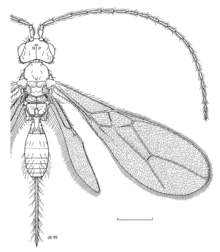Asobara
| Asobara | |
|---|---|

| |
| Asobara ajbelli by Des Helmore | |
| Scientific classification | |
| Kingdom: | |
| Phylum: | |
| Class: | |
| Order: | |
| Superfamily: | |
| Family: | |
| Subfamily: | |
| Genus: | Asobara Förster, 1862[1]
|
Asobara is a genus of parasitoid wasps in the family Braconidae. The genus is best known for the Drosophila parasitoid Asobara tabida, which is notable as both a model for parasitoid wasp infection in insects, and also as a representative of the hologenome theory of evolution.[2][3][4] Asobara tabida is commensally infected with Wolbachia, and cannot reproduce in the absence of Wolbachia infection. As such, the genome of Asobara is directly tied to the genome of its commensal Wolbachia symbiont, and the two are considered to have a hologenome.[4]
References[]
- ^ Förster, A. 1862: Synopsis der Familien und Gattungen der Braconen. Verhandlungen des Naturhistorischen Vereines preussischen Rheinlande und Westphalens 19: 225–288.
- ^ Van Alphen, J.J.M.; Janssen, A.R.M. (1981). "Host Selection By Asobara Tabida Nees (Braconidae; Alysiinae) a Larval Parasitoid of Fruit Inhabiting Drosophila Species". Netherlands Journal of Zoology. 32 (2): 194–214. doi:10.1163/002829682X00139. ISSN 0028-2960.
- ^ Eslin, Patrice; Prévost, Geneviève (1998). "Hemocyte load and immune resistance to Asobara tabida are correlated in species of the Drosophila melanogaster subgroup". Journal of Insect Physiology. 44 (9): 807–816. doi:10.1016/S0022-1910(98)00013-4. ISSN 0022-1910.
- ^ a b Dedeine F, Boulétreau M, Vavre F (2005). "Wolbachia requirement for oogenesis: occurrence within the genus Asobara (Hymenoptera, Braconidae) and evidence for intraspecific variation in A. tabida". Heredity (Edinb). 95 (5): 394–400. doi:10.1038/sj.hdy.6800739. PMID 16118660.
Further reading[]
- Poyet, Mathilde; Havard, Sebastien; Prevost, Genevieve; Chabrerie, Olivier; Doury, Geraldine; Gibert, Patricia; Eslin, Patrice (2013). "Resistance of Drosophila suzukii to the larval parasitoids Leptopilina heterotoma and Asobara japonica is related to haemocyte load". Physiological Entomology. 38 (1): 45–53. doi:10.1111/phen.12002. ISSN 0307-6962.
- Rolff, J., and A. R. Kraaijeveld. "Host preference and survival in selected lines of a Drosophila parasitoid, Asobara tabida." Journal of Evolutionary Biology 14.5 (2001): 742–745.
- Green, D. M., A. R. Kraaijeveld, and H. C. J. Godfray. "Evolutionary interactions between Drosophila melanogaster and its parasitoid Asobara tabida." Heredity85.5 (2000): 450–458.
- Moreau, Sébastien J.M.; Vinchon, Sophie; Cherqui, Anas; Prévost, Geneviève (2009). "Chapter 8 Components of Asobara Venoms and their Effects on Hosts". 70: 217–232. doi:10.1016/S0065-308X(09)70008-9. ISSN 0065-308X. Cite journal requires
|journal=(help) - Mabiala-Moundoungou, A.D.N.; Doury, G.; Eslin, P.; Cherqui, A.; Prévost, G. (2010). "Deadly venom of Asobara japonica parasitoid needs ovarian antidote to regulate host physiology". Journal of Insect Physiology. 56 (1): 35–41. doi:10.1016/j.jinsphys.2009.09.001. ISSN 0022-1910.
External links[]
- "Asobara" at the Encyclopedia of Life

Categories:
- Braconidae genera
- Ichneumonoidea stubs